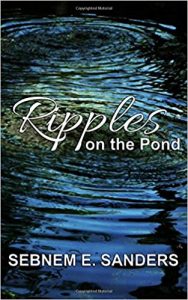Guest Post by Sebnem E. Sanders
I would like to thank Dedra L. Stevenson for inviting me to write a guest post at the Blue Jinni Media Blog. I’m delighted to be on this website, and while pondering about the subject matter, I decided to share my flash fiction experience with your readers.
Until I joined the now-defunct Harper Collins writers’ site, Authonomy, in 2012, I had written longer fiction and only a few short stories. A couple of years later, I began to participate in the flash fiction group there and submitted a story every week on a prompt set by the host. The members of the group welcomed me warmly which was encouraging. I noticed that my stories and writing improved over time. Their word count was 1000 or less. It was amazing to see how a story could be told effectively while striving to adhere to an economy of words. There isn’t much time for character development or elaborate settings. Start the plot in the middle, create something that grabs the reader’s attention, and nail it with a punchline, or the last sentence.
I remember being carried away once when my word count went over 2000. I cut it down to 1000, and the story still made sense. Less is more… After Authonomy closed down in 2015, the Flash Fiction group moved to Scribblers a site mainly for ex-Authonomites. I’ve been hosting the Flash Fiction thread there for the last three years or so, after the previous host, author Darius Stransky passed it over to me.
The reason I thought I’d talk about Flash Fiction is, although it’s popular in the literary circles, many people, including writers, don’t know much about it. Recently, an author asked me what it meant. My own definition is as follows: Flash Fiction is a short story, with a beginning, a middle, and an end, usually no longer than 1000 words. Some word counts go up to 1250, but no higher. Then there are stories around 500 words, and I’ve read many excellent tales of this size. At the bottom of the spectrum, they go down to 350, 250, 150, and 100 words, which is called a drabble.
My first published stories at online magazines were drabbles. It is possible to compose a gripping story in 100 words. For me, the most testing ones are between 150-350 words. Neither short nor long. I find it very difficult to create something that makes an impact around this length. Around 500 words, is another challenge. Not all stories can be told within this word count. However, I tried very hard to write something original with a twist at the end and managed to get two of my stories published at Spelk Fiction one of my favourite online literary magazines. And a new one is to be published there in December.
There is also micro fiction, 50-word stories, and six-word stories, the most famous one written by Hemingway, For sale: Baby shoes, never worn. So brief, thought-provoking, and poignant. One could write a novel on that. An author friend of mine, Richard Ankers writes excellent 6-word stories. They grip the reader, sometimes leaving you wordless. Kate Murdoch another talented author friend, weaves the most striking 500-word stories. Author Diana Wallace Peach at Myths of the Mirror is a wonderful wordsmith who transports you to another world in a brief flash.
At the end of four years of writing flash fiction every week, I ended up with 150 stories. Some of these were published in literary magazines in the UK, US, and Canada which gave me courage. An author friend of mine, David J. Meyers at The Gargoyle Chronicles encouraged me to publish an anthology before venturing into the scene with longer fiction. He said it would give me the experience and the exposure. So I chose seventy out of the collection and published my debut book in December 2017. The stories in Ripples on the Pond are of various lengths, the majority being around 1000 words, some developed into slightly longer versions. There are only three stories around 2000 words, an experimental length for me.
I would recommend to every writer to experiment with flash fiction. The exercise definitely improves one’s style in composing a story with less detail and without repetition. Here’s an open invitation to join us at Scribblers. We’re a small group of friendly writers, and newcomers are always welcome. Here’s the link to our latest thread: http://scribblers.freeforums.net/thread/1135/flash-fiction-october-26th-2018
Flash fiction has become a popular genre for people who have limited time to read. Often called bite-size stories or lunchtime stories, they’re brief enough to enjoy during a short break, a train or a bus ride, on the phone or a tablet, yet creative works that make the reader ponder in how they depict the human experience in a nutshell.
Short Bio:

Sebnem Sandars – Author
Sebnem E. Sanders is a native of Istanbul, Turkey. Currently, she lives on the eastern shores of the Southern Aegean where she dreams and writes Flash Fiction and Flash Poesy, as well as longer works of fiction. Her flash stories have been published on the Harper Collins Authonomy Blog, The Drabble, Sick Lit Magazine, Twisted Sister Lit Mag, Spelk Fiction, The Bosphorus Review of Books, Three Drops from the Cauldron, The Rye Whiskey Review, and CarpeArte Journal. She has a completed manuscript, The Child of Heaven and two works in progress, The Child of Passion and The Lost Child. Her collection of short and flash fiction stories, Ripples on the Pond, was published in December 2017. Her stories have also been published in two Anthologies: Paws and Claws and One Million Project, Thriller Anthology.
More information can be found at her website where she publishes some of her work:
- https://sebnemsanders.wordpress.com/
- https://twitter.com/sebnemsanders
- https://www.goodreads.com/author/show/17427985.Sebnem_E_Sanders
- https://www.instagram.com/sebnemsanders/
- https://www.facebook.com/sebnem.sanders
- https://www.linkedin.com/in/sebnem-sanders-b3593263/





Flas. Fiction and what it is. Great description seb. Well done.
Great article from a writer who encapsulates all that is good in fiction.